 THE MINERAL ASTROPHYLLITE
THE MINERAL ASTROPHYLLITE
- Chemistry: (K,Na)3(Fe,Mn)7Ti2(SiO3)8(O,OH)7, Potassium Sodium Iron Manganese Titanium Silicate Hydroxide.
- Class: Silicates
- Subclass: Inosilicates
- Group: Astrophyllite
- Uses: mineral specimen
Specimens
PHYSICAL CHARACTERISTICS:
- Color is usually golden yellow or yellowish brown, but also greenish brown specimens are found.
- Luster is vitreous or submetallic to metallic, can be pearly on cleavage surfaces.
- Transparency: crystals are translucent to opaque.
- Crystal System is triclinic; bar 1
- Crystal Habits include small tabular or bladed crystals often grouped in starlike aggregates. Also found in lamellar massives.
- Cleavage is perfect in one direction.
- Fracture is uneven.
- Hardness is 3.
- Specific Gravity is 3.3 - 3.4
- Streak is yellowish white.
- Associated Minerals are quartz, feldspars, nepheline, micas and aegirine.
- Other Characteristics: color is often patchy or heterogenous in distribution.
- Notable Occurrences include Kola Penensula, Khibina, Russia; Colorado, USA and Mt St. Hilaire, Quebec, Canada.
- Best Field Indicators brittleness, cleavage, color, luster and localities.
 Amethyst Galleries' Mineral Gallery MINERALS |
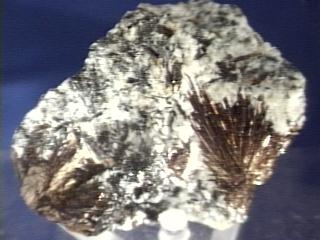
ASTROPHYLLITE specimen ast-2
$ 45.00
$ 45.00
Dims: 3" x 2-1/2" x 3/4"
Wt: 3.5 oz. .... Kola Peninsula, Khibina, Russia
The Astrophyllites on this specimen occur in sunburst clusters, with dozens of flat needles radiating from two points on the matrix. There are a few crystals occurring separately in the piece, but they are overwhelmed by a large number of what I think are Acmite crystals that show a black color and a shiny, vitreous luster. This piece is really very beautiful in a bright incandescent light.
The Astrophyllites on this specimen occur in sunburst clusters, with dozens of flat needles radiating from two points on the matrix. There are a few crystals occurring separately in the piece, but they are overwhelmed by a large number of what I think are Acmite crystals that show a black color and a shiny, vitreous luster. This piece is really very beautiful in a bright incandescent light.
The Astrophyllites on this specimen occur in sunburst clusters, with dozens of flat needles radiating from two points on the matrix. There are a few crystals occurring separately in the piece, but they are overwhelmed by a large number of what I think are Acmite crystals that show a black color and a shiny, vitreous luster. This piece is really very beautiful in a bright incandescent light.

ast-2 ($ 45.00)
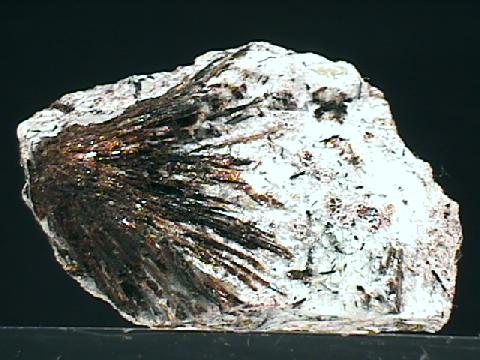
ASTROPHYLLITE specimen ast-4
$ 30.00
$ 30.00
Dims: 2" x 1-1/2" x 1-1/4"
Wt: 2 oz. .... Kola Peninsula, Khibina, Russia
The flat, brown needles of Astrophyllite, with their pearly, submetallic luster, emanate from a single point on one edge of the piece, achieving lengths of one inch or more. Elsewhere on the specimen, smaller, individual crystals are randomly strewn.
The flat, brown needles of Astrophyllite, with their pearly, submetallic luster, emanate from a single point on one edge of the piece, achieving lengths of one inch or more. Elsewhere on the specimen, smaller, individual crystals are randomly strewn.
The flat, brown needles of Astrophyllite, with their pearly, submetallic luster, emanate from a single point on one edge of the piece, achieving lengths of one inch or more. Elsewhere on the specimen, smaller, individual crystals are randomly strewn.

ast-4 ($ 30.00)
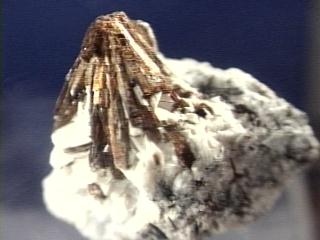
ASTROPHYLLITE specimen ast-5
$ 15.00
$ 15.00
Dims: 1-3/4" x 1-1/4" x 1-1/4"
Wt: 1.4 oz. .... Kola Peninsula, Khibina, Russia
A spray of crystals about 3/4 inch in diameter steals the show, with crystals up to an inch long growing from it. The point from which they grow is about 3/8 inch from the host rock, with the crystals spreading downward into the matrix. For the rarity of this mineral and the beauty of this cluster, the price is negligible.
A spray of crystals about 3/4 inch in diameter steals the show, with crystals up to an inch long growing from it. The point from which they grow is about 3/8 inch from the host rock, with the crystals spreading downward into the matrix. For the rarity of this mineral and the beauty of this cluster, the price is negligible.
A spray of crystals about 3/4 inch in diameter steals the show, with crystals up to an inch long growing from it. The point from which they grow is about 3/8 inch from the host rock, with the crystals spreading downward into the matrix. For the rarity of this mineral and the beauty of this cluster, the price is negligible.

ast-5 ($ 15.00)
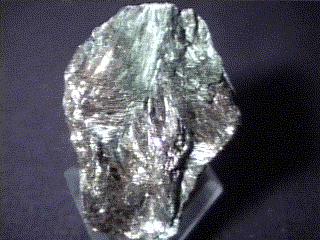
ASTROPHYLLITE specimen ast-6
$ 75.00
$ 75.00
Dims: 2-7/8" x 2-1/8" x 1-1/4"
Wt: 4.08 oz. .... Kola Peninsula, Khibina, Russia
This piece is the largest Kola Peninsula specimen of Astrophyllite that I have yet seen. It seems that this specimen is made up of several clusters of Astrophyllite that are enmeshed with a matrix of what seems to be green mica schist! There is a small amount of a translucent mineral(possiobly calcite?) on part of the specimen. This is a rather tough piece to figure out-- there is a lot of "interaction" between the Astrophyllite and the schist matrix.
This piece is the largest Kola Peninsula specimen of Astrophyllite that I have yet seen. It seems that this specimen is made up of several clusters of Astrophyllite that are enmeshed with a matrix of what seems to be green mica schist! There is a small amount of a translucent mineral(possiobly calcite?) on part of the specimen. This is a rather tough piece to figure out-- there is a lot of "interaction" between the Astrophyllite and the schist matrix.
This piece is the largest Kola Peninsula specimen of Astrophyllite that I have yet seen. It seems that this specimen is made up of several clusters of Astrophyllite that are enmeshed with a matrix of what seems to be green mica schist! There is a small amount of a translucent mineral(possiobly calcite?) on part of the specimen. This is a rather tough piece to figure out-- there is a lot of "interaction" between the Astrophyllite and the schist matrix.

ast-6 ($ 75.00)
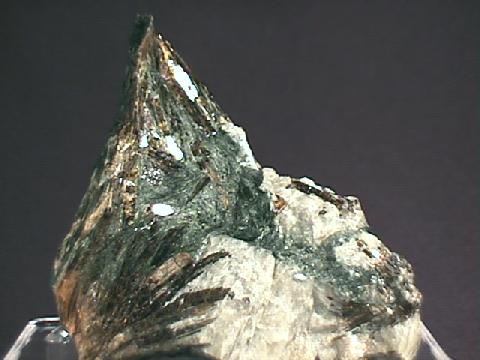
ASTROPHYLLITE specimen ast-7
$ 75.00
$ 75.00
Dims: 3.2" x 2.2" x 1.6" (8.1 x 5.6 x 4.1 cm)
Wt: 4.08 oz. .... Kola Peninsula, Khibina, Russia
At least 3 noticeable sprays of Astrophyllite blades are heavily intergrown with the green and white host rock of this specimen. The blades on these clusters reach lengths of 1.3" (3.3 cm) and show considerable damage, likely due to the mining of the piece itself. The blades have the standard brownish color and micaceous/metallic luster that is common for Astrophyllite and shows a bright, pearly luster. The host rock in which they are embedded appears to be made up of a white feldspar of some sort that broke apart and is held together by an almost massive, green mica or schist that filled in the spaces caused by the breakage.
At least 3 noticeable sprays of Astrophyllite blades are heavily intergrown with the green and white host rock of this specimen. The blades on these clusters reach lengths of 1.3" (3.3 cm) and show considerable damage, likely due to the mining of the piece itself. The blades have the standard brownish color and micaceous/metallic luster that is common for Astrophyllite and shows a bright, pearly luster. The host rock in which they are embedded appears to be made up of a white feldspar of some sort that broke apart and is held together by an almost massive, green mica or schist that filled in the spaces caused by the breakage.
At least 3 noticeable sprays of Astrophyllite blades are heavily intergrown with the green and white host rock of this specimen. The blades on these clusters reach lengths of 1.3" (3.3 cm) and show considerable damage, likely due to the mining of the piece itself. The blades have the standard brownish color and micaceous/metallic luster that is common for Astrophyllite and shows a bright, pearly luster. The host rock in which they are embedded appears to be made up of a white feldspar of some sort that broke apart and is held together by an almost massive, green mica or schist that filled in the spaces caused by the breakage.
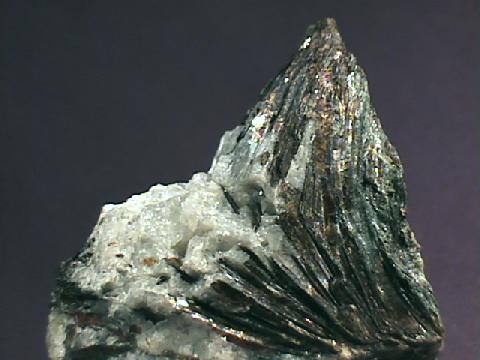

ast-7 ($ 75.00)
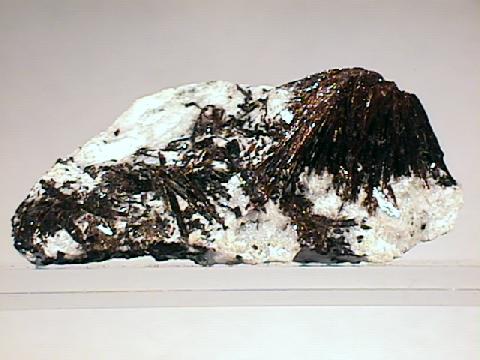
ASTROPHYLLITE specimen ast-8
$ 45.00
$ 45.00
Dims: 2.8 x 1.5 x 1.2" (7.1 x 3.7 x 3.1 cm)
Wt: 3.04 oz. (86.4 g)
Kola Peninsula, Khibine, Russia
A few clusters and many loose crystals of Astrophyllite are embedded in the host rock of this hand specimen. These crystals are either broken or so heavily intergrown that they cannot be studied as individuals. They have a red-brown color with golden highlights and a nearly metallic luster, and are translucent to transparent.

ast-8 ($ 45.00)
Kola Peninsula, Khibine, Russia
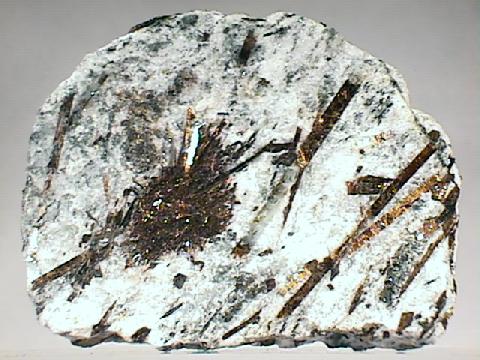
ASTROPHYLLITE specimen ast-9
$ 60.00
$ 60.00
Dims: 3.3 x 2.6 x 1.2" (8.4 x 6.6 x 3.1 cm)
Wt: 6.55 oz. (185.8 g)
Kola Peninsula, Khibine, Russia
This hand specimen consists of a chunk of white syenite host rock that is permeated with at least one Astrophyllite cluster and many blades. Some of these blades are quite large, reaching lengths of 1.9" (4.7 cm). All have the standard red-brown coloration with golden highlights and a pearly, almost metallic luster. They appear to have a nearly micaceous separation and may be translucent or even transparent.

ast-9 ($ 60.00)
Kola Peninsula, Khibine, Russia
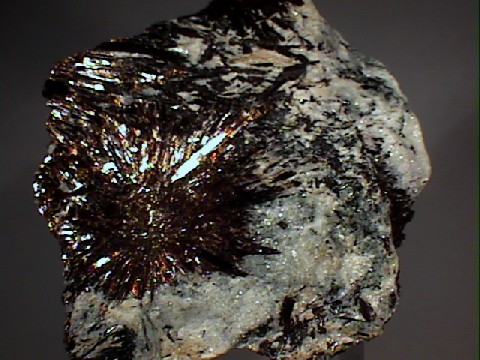
ASTROPHYLLITE specimen ast-10
$ 60.00
$ 60.00
Dims:4.0x3.4x1.1" (10.1x8.6x2.8 cm)
Wt: 9.6oz. (271g)
Khibiny Massif, Kola Peninsula, Russia
Excellent radial sprays of astrophyllite are found in this specimen. The astrophyllite crystals permeate the entire matrix. The matrix consists of quartz, with some plagioclase, biotite, and amphibole present. Without access to thin section examination, I would call this a granodiorite. The astrophyllite blades reach 1.1" (2.8cm) in length and are golden-brown in color.


ast-10 ($ 60.00)
Khibiny Massif, Kola Peninsula, Russia
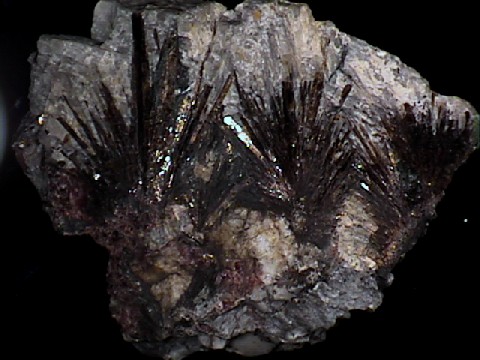
ASTROPHYLLITE specimen ast-11
$ 69.00
$ 69.00
Dims: 3.81x2.86x1.52" (9.67x7.26x3.86cm)
Wt: 9.41oz (266.2g)
Khibiny, Russia
This astrophyllite hand specimen boasts three large sprays of the crystals on an impure calcite host. The largest crystal measures 40mm long and 4mm wide, and the clean crystals on the front of the piece have a good vitreous luster and brassy color. Examination with a loupe shows that the color picture is much more complex - each crystal is a montage of colored segments, all different shades of gold, brass, copper, or brown, put together like a stained glass window. Very pretty, and too bad that a loupe is needed to appreciate this. Where the rock is broken away, the three-dimensional nature of the crystal sprays is visible (at first glance, it looks like the crystals are all flat against the specimen). And a close examination reveals a half-dozen additional clusters, although these tend to be small and weathered (with a dull luster).
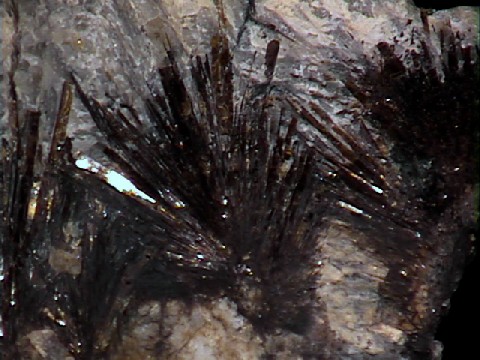

ast-11 ($ 69.00)
Khibiny, Russia
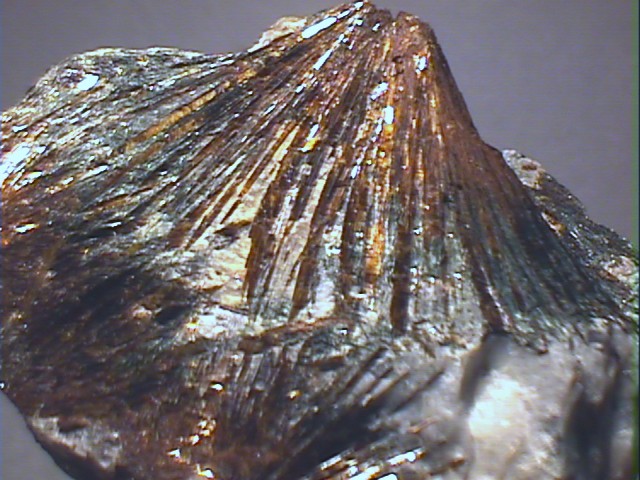
ASTROPHYLLITE specimen ast-12
$ 45.00
$ 45.00
Dims: 2.63x2.15x1.68" (6.68x5.46x4.26cm)
Wt: 6.68oz (189g)
Khibiny, Russia
This astrophyllite specimen is composed of several radial clusters that look as though they formed from a half-dozen attachment points on the sides of a cavity, a spread into the center. They (along with other minerals including quartz and albite) filled the cavity. The largest clusters of astrophyllite are quite nice, with long gold and black crystals having a vitreous luster and a surface texture showing many fine layers due to a fracture pattern.

ast-12 ($ 45.00)
Khibiny, Russia
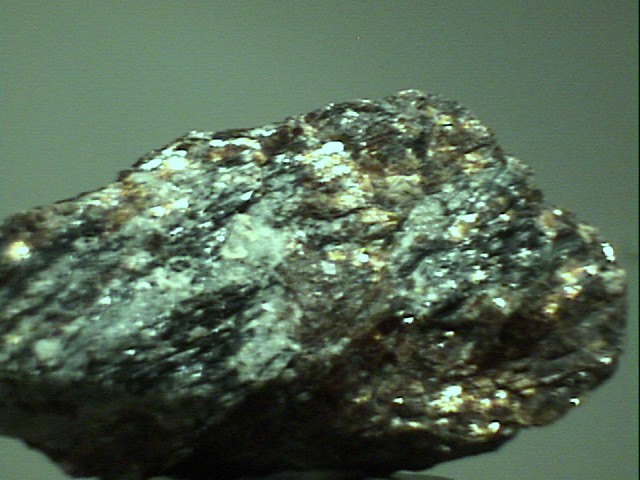
ASTROPHYLLITE specimen ast-13
$ 25.00
$ 25.00
Dims: 2.97x1.39x0.57" (7.55x3.52x1.44cm)
Wt: 0.76oz (21.6g)
Khibiny, Russia
This specimen is largely astrophyllite, although there is a significant amount of quartz present. The specimen has been polished to a high gloss on one side, which appears black with gold and red highlights reminescent of some opals I've seen. The back of the specimen is rough, with black and gold crystals in the quartz matrix. A loupe reveals that the astrophyllite crystals have an appealing irridescent pattern of golds, oranges, and reds, and also that the black mineral must be more astrophyllite that has weathered to a black which is irridescent in shades of very dark green and blue. The orange crystals appear translucent in thin sections.

ast-13 ($ 25.00)
Khibiny, Russia